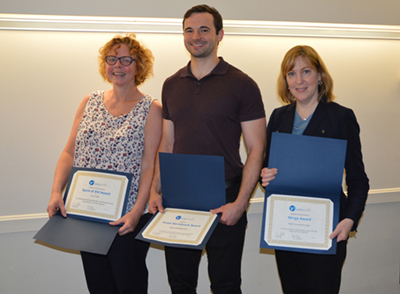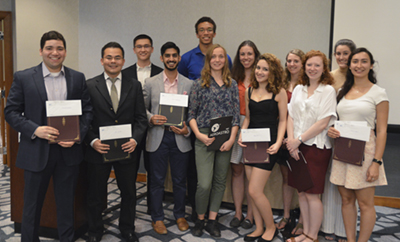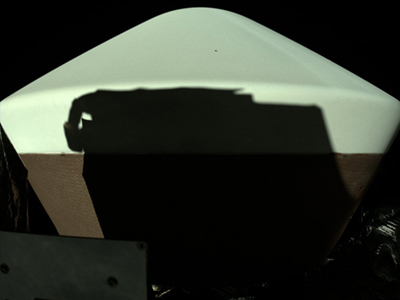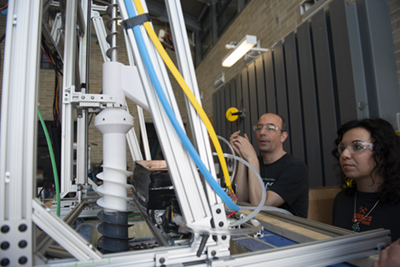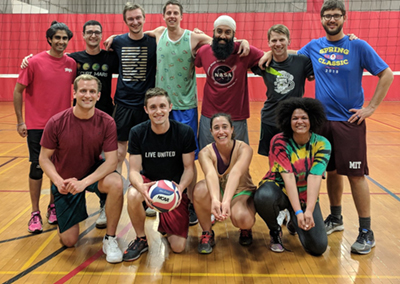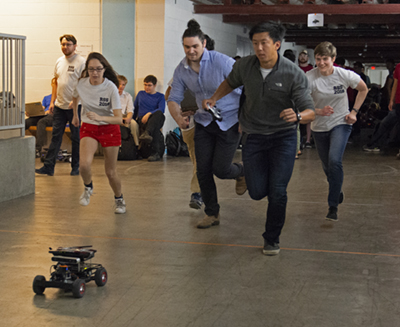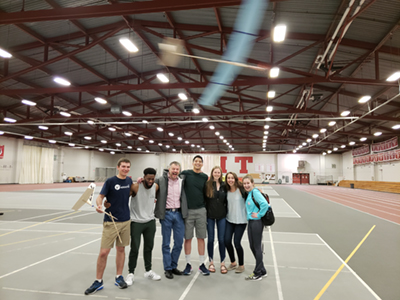June 2018In this issue: |
|
|
1. Awards, honors, promotionsProfessor Qiqi Wang has been promoted to Associate Professor with Tenure. Wang investigates engineering design involving chaotic dynamical systems, unsteady aerodynamics and turbulence, numerical methods for exascale computation, and design optimization under uncertainty. Dr. Rebecca Masterson has received a promotion to Principal Research Scientist. The Aerospace Medical Association's Life Sciences and Biomedical Engineering Branch has presented Professor Emeritus Larry Young with its Professional Excellence Award for Sustained Lifetime Contributions. The National Academy of Engineering has elected Professor Wes Harris as an NAE Councillor. The MIT Office of Undergraduate Education has announced that Professor Raúl Radovitzky will be honored with the Alan J. Lazarus Award for Excellence in Freshman Advising. The award is "presented to a faculty member who has served as an excellent advisor and mentor to first year students, and who has had a significant impact on their personal lives and academic success." Professor Dava Newman has been named an AIAA Fellow. The AIAA says, "Fellows are persons of distinction in aeronautics or astronautics who have made notable and valuable contributions to the arts, sciences, or technology thereof." She has also received the AIAA Jeffries Aerospace Medicine and Life Sciences Research Award for "sustained, exceptional contributions to the mechanics and energetic requirements of human performance across the continuum of gravity, advanced space suit design and navigation aids for EVA astronauts." Graduate student Frederick Daso has been presented a 2018 National Defense Science and Engineering Graduate Fellowship. Daso is a research assistant in Professor Brian L. Wardle’s necstlab. Professor Eytan Modiano, graduate student Igor Kadota, and Abhishek Sinha (PhD '17) received Best Paper Award at this year's Infocom conference, the premier conference on networking. The paper's title is "Optimizing Age of Information in Wireless Networks with Throughput Constraints." There were more than 1,500 papers submitted, of which 300 were accepted. Professor Luca Carlone and co-authors received the Best Paper Award at the IEEE International Conference on Robotics and Automation for “On-Manifold Preintegration for Real-Time Visual-Inertial Odometr.". The award "recognizes the best paper published in 2017 on IEEE Transactions on Robotics, based on the technical merit, originality, potential impact on the field, clarity of presentation, and practical significance for applications." The Zonta International Foundation has named AeroAstro grad students Carla Grobler, Akshata Krishnamurthy, and Jacqueline Thomas recipients of its 2018 Amelia Earhart Fellowships. The fellowships are awarded annually to women pursuing doctoral degrees in aerospace-related sciences or aerospace-related engineering.
|
|
2. WelcomeWelcome to our newest faculty member, Richard Linares. Linares comes to AeroAstro from the University of Minnesota’s Aerospace Engineering and Mechanics Department where he was an assistant professor. He received his B.S., M.S. and Ph.D. degrees in aerospace engineering from the State University of New York at Buffalo. He was a Director’s Postdoctoral Fellow at Los Alamos National Laboratory and held a postdoctoral associate appointment at the United States Naval Observatory. "I'm thrilled to join the AeroAstro department and I am honored by the warm reception I've received from the faculty, staff, and students,” Richard says Richard Linares' research areas are astrodynamics, space situational awareness, satellite guidance and navigation, estimation and controls, and reinforcement learning. His work focuses on the development of new nonlinear estimation and controls approaches with application to space traffic management and space exploration. Welcome to Vladimir Leopard, new AeroAstro administrative assistant. He'll be supporting Professors Barrett and Leveson, and Dr. Belobaba. Vlad comes to us from the Biomaterials Science and Engineering Laboratory where he worked as an admin assistant. Previously, he was an MIT Center of Biomedical Engineering lab assistant. With a degree in Science, Earth and Hydrological Sciences, Vlad will also provide Prof. Barrett’s Laboratory for Aviation and the Environment with additional research expertise and support. Irene Dedoussi, who's been an RA in the Laboratory for Aviation and the Environment, has received her PhD and will continue with LAE as a postdoc. And, wecome to our newest student organization, AeroAfro. "AeroAfro is an unofficial organization that seeks to advance the diversity and inclusion initiative of the MIT of Aeronautics and Astronautics. The goal of this group is to provide a sense of community and support amongst the African Diasporic graduate students within the department through social gatherings and occasional informational events." For more info, contact aeroafro-exec@mit.edu. |
3. Senior awards presented
At the department's May 14 Senior Awards Dinner, graduating seniors were honored with the following awards:
|
|
4. Rexis sees its shadowOn March 8, 2018, NASA's OSIRIS-REx captured the above image showing the shadow of the spacecraft’s REXIS instrument projected onto the Sample Return Capsule. REXIS is the student collaboration instrument aboard the OSIRIS-REx Asteroid Sample-Return Mission. It was designed and built by 16.831 (Space Systems Development) and Space Systems Laboratory students under the guidance of SSL, MKI, Lincoln Laboratory, and Harvard College Observatory faculty and staff. OSIRIS-REx is on the way to the near-Earth asteroid Bennu to harvest a sample of surface material and return it to Earth for study. But before the science team selects a sample site, they can find out a bit about Bennu's elemental makeup. The spacecraft's Regolith X-ray Imaging Spectrometer, or REXIS, can image X-ray emission from Bennu to provide an elemental abundance map of the asteroid's surface. REXIS co-PI/Instrument Manager, Principal Researcher Becky Masterson, notes that the spacecraft has already traveled the farthest from Earth of any hardware built in the AeroAstro Department. REXIS was initiated by Professor David Miller, then director of the SSL. AeroAstro/EAPS Professor Richard Binzel is the Co-PI and Instrument Scientist. |
|
5. MIT and the Mars Ice ChallengeGrad student George Lordos writes: Thick ice sheets covered by regolith are believed to exist at several sites across the mid-latitudes of Mars, and NASA is interested in innovative solutions for producing water for use by future crews on Mars. A team from MIT was among 10 finalist university teams participating in the June RASC-AL Special Edition Mars Ice Challenge at NASA Langley. The Challenge involved the design, build and operation of a prototype Mars water extraction system. At the award ceremony, the MIT team won Best Technical Paper for a paper detailing path-to-flight design modifications for extracting water from Martian subsurface ice. This best paper award was shared with Virginia Tech. The MIT team was also one of five teams to successfully recover water from a simulated Martian environment. The MIT design, named High Yield Dihydrogen monoxide Retrieval Assembly (HYDRA), is a remotely-controlled system featuring counter-rotating augers with an innovative mechanical coupling. The outer 3D-printed ABS 4” auger and the inner, steel 2” auger can be used in a variety of coupled or uncoupled modes, depending on drilling site conditions. Ice mining and water recovery technology will be critical parts of any mission to establish permanent human outposts on Mars. HYDRA team members are graduate students Ignacio Arzuaga (CEE), Eric Hinterman (AeroAstro), Chunwei Ge (CEE), Meghan Maupin (IDM), Matthew Moraguez (AeroAstro), George Lordos (AeroAstro and SDM), Valentina Sumini (post-doc Media Lab), Alejandro Trujillo (AeroAstro) and Rafael Villamor (CEE). Advisors are Professors Jeff Hoffman, Herbert Einstein, Martin Culpepper, and Dr. Afreen Siddiqi and Dr. Michael Hecht. |
|
6. In the picture |
|
WINNERS! — AeroAstro B-CoEd volleyball team - 2018 Intramural champs! (From left front)) Jasper Arneberg, Eric Hinterman, Julia Docampo, Cadence PayneBack, (back) Pratik Dave, Alex Trujillo, Thibaud Fritz, Albert Gnadt, Indy Grewal, Nick Anastas, and Bobby Hold. |
|
HAPPY 12TH — Space Systems Lab's SPHERES mark 12 years aboard the International Space Station. The little satellites started as a 16.83x Space Systems Engineering class project. The photo depicts German/European Space Agency astronaut Alexander Gerst during a test session. Orange and Blue SPHERES are doing a collaborative inspection of a tumbling target (Red) to map it and determine its inertial properties using visual data from stereoscopic cameras. |
|
COMPETITION — An autonomous race car from the 16.405/6.141 Robotics: Science and Systems class rips through the Stata Building basement with its student team (L to R) Carla Nicole Pinzon, Liam Cohen, Richard Yip, and Jocelyn Lorrey in hot pursuit! The students had a blast at the May 14 event implementing autonomous navigation algorithms for the little speedsters. |
|
UNIFIED FLYING — Professor Dave Darmofal supplies the above photo, taken at the completion of the Unified Engineering Flight Competition. He notes "it was after the competition was over, and some planes were being flown around, with less concern about successful landings, since the competition was done," and draws attention to "the top of the image where you'll see the blur of a plane." In the photo are (L to R) Sam Austin, Timmy Hussain, Dave Darmofal, KJ Hardrict, Aigneis Frey, Alex Forsey-Smerek, and Maddie Garcia. Watch a plane's-eye view of the competition, produced by student Federico Bescotti. |
|







 Daso
Daso Modiano
Modiano Kadota
Kadota Sinha
Sinha 



